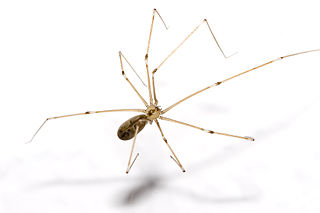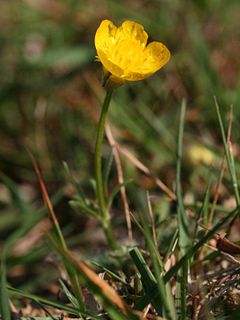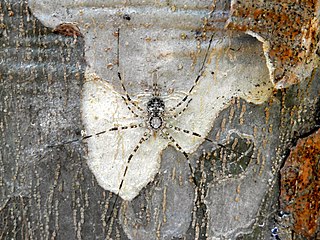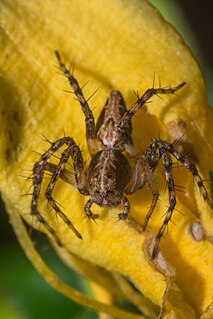
The Pholcidae are a family of araneomorph spiders. The family contains over 1,800 pholcids, including those commonly known as the marbled cellar spider , daddy long-legs spider, granddaddy long-legs spider, carpenter spider, daddy long-legger, vibrating spider, gyrating spider, long daddy, and skull spider. The family, first described by Carl Ludwig Koch in 1850, is divided into 94 genera.

Ranunculus bulbosus, commonly known as bulbous buttercup or St. Anthony's turnip, is a perennial flowering plant in the buttercup family Ranunculaceae. It has bright yellow flowers, and deeply divided, three-lobed long-petioled basal leaves.
Ceratinella is a genus of dwarf spiders that was first described by James Henry Emerton in 1882. They are very similar to both Ceraticelus and Idionella, and the taxonomy of these spiders may change.

Ceraticelus is a genus of dwarf spiders that was first described by Eugène Louis Simon in 1884.
Ceraticelus innominabilis is a spider in the family Linyphiidae. It is found in Alaska.
Maro is a genus of dwarf spiders that was first described by Octavius Pickard-Cambridge in 1907.
Sesieutes is a genus of Asian liocranid sac spiders first described by Eugène Simon in 1897. It was briefly transferred to the Corinnidae in 2013, but was returned a year later due to its similarity and relation to Phrurolithus.

Ceraticelus fissiceps is a species of dwarf spider in the family Linyphiidae. It is found in the United States and Canada.
Ceraticelus crassiceps is a species of dwarf spider in the family Linyphiidae. It is found in the United States.
Ceraticelus atriceps is a species of dwarf spider in the family Linyphiidae. It is found in the United States.
Ceraticelus laetabilis is a species of dwarf spider in the family Linyphiidae. It is found in the United States and Canada.

Neotama mexicana, also known as the long-spinneret spider or Mexican two-tailed spider, is a species of tree trunk spider in the family Hersiliidae. It is found in a range from the United States to Peru and Guyana.
Pityohyphantes costatus, the hammock spider, is a species of sheetweb spider in the family Linyphiidae. It is found in the United States.
Ceraticelus emertoni is a species of dwarf spider in the family Linyphiidae. It is found in the United States.
Ceraticelus minutus is a species of dwarf spider in the family Linyphiidae. It is found in the United States and Canada.
Xysticus emertoni, or Emerton's crab spider, is a species of crab spider in the family Thomisidae. It is found in the United States, Canada, Slovakia, Russia, and a range from Central Asia to China.

Pirata piraticus is a species of wolf spider in the family Lycosidae. It is found in North America, Europe, Turkey, Caucasus, a range from Russia, Central Asia, China, and Japan.
Ceraticelus similis is a species of dwarf spider in the family Linyphiidae. It is found in the United States.

Phidippus apacheanus is a species of jumping spider in the family Salticidae. It is found in the United States, Mexico, and Cuba.

Oxyopes scalaris, the western lynx spider, is a species of lynx spider in the family Oxyopidae. It is found in North America.






